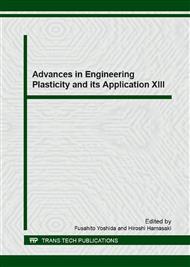[1]
J.F. Stebbins, S.E. Ellsworth, Temperature effects on structure and dynamics in borate and borosilicate liquids: High-resolution and high-temperature NMR results, J Am Ceram Soc. 79 (1996) 2247-2256.
DOI: 10.1111/j.1151-2916.1996.tb08969.x
Google Scholar
[2]
L. Pedesseau, S. Ispas, W. Kob, First-principles study of a sodium borosilicate glass-former. I. The liquid state, Phys Rev B. 91 (2015) 134201.
DOI: 10.1103/physrevb.91.134201
Google Scholar
[3]
L. Pedesseau, S. Ispas, W. Kob, First-principles study of a sodium borosilicate glass-former. II. The glass state, Phys Rev B. 91 (2015) 134202.
DOI: 10.1103/physrevb.91.134202
Google Scholar
[4]
L. Cormier, O. Majerus, D.R. Neuville, G. Calas, Temperature-induced structural modifications between alkali borate glasses and melts, J Am Ceram Soc. 89 (2006) 13-19.
DOI: 10.1111/j.1551-2916.2005.00657.x
Google Scholar
[5]
S. Sen, Temperature induced structural changes and transport mechanisms in borate, borosilicate and boroaluminate liquids: high-resolution and high-temperature NMR results, J Non-Cryst Solids. 253 (1999) 84-94.
DOI: 10.1016/s0022-3093(99)00346-4
Google Scholar
[6]
P.J. Bray, Nuclear Magnetic-Resonance Studies of Glass Structure, J Non-Cryst Solids. 73 (1985) 19-45.
DOI: 10.1016/0022-3093(85)90335-7
Google Scholar
[7]
W.J. Dell, P.J. Bray, S.Z. Xiao, B-11 Nmr-Studies and Structural Modeling of Na2o-B2o3-Sio2 Glasses of High Soda Content, J Non-Cryst Solids. 58 (1983) 1-16.
DOI: 10.1016/0022-3093(83)90097-2
Google Scholar
[8]
B.C. Bunker, D.R. Tallant, R.J. Kirkpatrick, G.L. Turner, Multinuclear Nuclear-Magnetic-Resonance and Raman Investigation of Sodium Borosilicate Glass Structures, Phys Chem Glasses. 31 (1990) 30-41.
Google Scholar
[9]
G.L. Turner, K.A. Smith, R.J. Kirkpatrick, E. Oldfield, B-11 Nuclear-Magnetic-Resonance Spectroscopic Study of Borate and Borosilicate Minerals and a Borosilicate Glass, J Magn Reson. 67 (1986) 544-550.
DOI: 10.1016/0022-2364(86)90391-4
Google Scholar
[10]
T. Edwards, T. Endo, J.H. Walton, S. Sen, Observation of the transition state for pressure-induced BO3 -> BO4 conversion in glass, Science. 345 (2014) 1027-1029.
DOI: 10.1126/science.1256224
Google Scholar
[11]
J.M. Soler, E. Artacho, J.D. Gale, A. Garcia, J. Junquera, P. Ordejon, D. Sanchez-Portal, The SIESTA method for ab initio order-N materials simulation, J Phys-Condens Mat. 14 (2002) 2745-2779.
DOI: 10.1088/0953-8984/14/11/302
Google Scholar
[12]
J.P. Perdew, K. Burke, M. Ernzerhof, Generalized gradient approximation made simple, Phys Rev Lett. 77 (1996) 3865-3868.
DOI: 10.1103/physrevlett.77.3865
Google Scholar
[13]
N. Troullier, J.L. Martins, Efficient Pseudopotentials for Plane-Wave Calculations, Phys Rev B. 43 (1991) 1993-(2006).
DOI: 10.1103/physrevb.43.1993
Google Scholar
[14]
H.J. Monkhorst, J.D. Pack, Special Points for Brillouin-Zone Integrations, Phys Rev B. 13 (1976) 5188-5192.
DOI: 10.1103/physrevb.13.5188
Google Scholar
[15]
S. Nose, A Unified Formulation of the Constant Temperature Molecular-Dynamics Methods, J Chem Phys. 81 (1984) 511-519.
Google Scholar
[16]
S. Nose, A Molecular-Dynamics Method for Simulations in the Canonical Ensemble, Mol Phys. 52 (1984) 255-268.
Google Scholar
[17]
M. Parrinello, A. Rahman, Crystal-Structure and Pair Potentials - a Molecular-Dynamics Study, Phys Rev Lett. 45 (1980) 1196-1199.
DOI: 10.1103/physrevlett.45.1196
Google Scholar
[18]
M. Parrinello, A. Rahman, Polymorphic Transitions in Single-Crystals - a New Molecular-Dynamics Method, J Appl Phys. 52 (1981) 7182-7190.
DOI: 10.1063/1.328693
Google Scholar
[19]
L. Pedesseau, S. Ispas, W. Kob, First-principles study of a sodium borosilicate glass-former. I. The liquid state, Phys Rev B. 91 (2015).
DOI: 10.1103/physrevb.91.134201
Google Scholar


